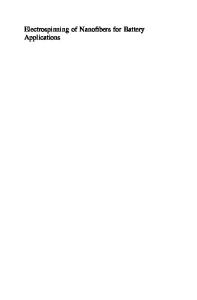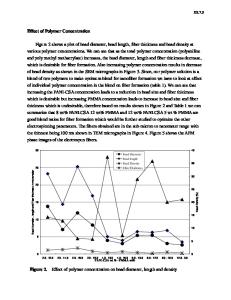Electric field analysis of spinneret design for needleless electrospinning of nanofibers
- PDF / 648,530 Bytes
- 7 Pages / 584.957 x 782.986 pts Page_size
- 96 Downloads / 299 Views
ngai Wang Australian Future Fibres Research and Innovation Centre, Deakin University, Geelong, Victoria 3217, Australia; and School of Textile Science and Engineering, Wuhan Textile University, Wuhan 430200, China
Tong Linb) Australian Future Fibres Research and Innovation Centre, Deakin University, Geelong, Victoria 3217, Australia (Received 4 July 2012; accepted 28 September 2012)
Concentrated electric field is crucial in generation of needleless electrospinning; the electric field profile together with electric field intensity of the spinneret directly affect the needleless electrospinning performance. Understanding the electric field of different spinnerets would definitely benefit the design and optimization of needleless electrospinning. Three-dimensional (3D) finite element analysis has been used to analyze the electric field profile and electric field intensity of different spinnerets for needleless electrospinning by using the simulation software COMSOL Multiphysics 3.5a. It has been found that evolution of the spinneret of needleless electrospinning from cylinder to multiple disks and then to multiple rings results in stronger and more concentrated electric field. The analysis based on 3D simulation of the electric field could benefit further development of needleless electrospinning in which the production rate and quality of as-spun nanofibers are of great importance. I. INTRODUCTION
Electrospinning has been widely used to produce nanofibers,1,2 and electrospun nanofibers have shown potential in different applications.3 However, the extremely low production rate, usually less than 0.1 g/h,4 limits further application and commercialization of nanofibers. Efforts have been made to increase the production rate of nanofibers in electrospinning by using multiple needles/channels.5–8 However, strong charge repulsion between neighboring polymer jets and clogging of the needles/channels affects either the spinning process or the quality of the as-spun nanofibers. Needleless electrospinning has been reported to increase the productivity of nanofibers.9–11 It shows great potential in enhancing the productivity of nanofibers as numerous polymer jets were generated at the same time and uniform nanofibers were produced. The generation of multiple jets in needleless electrospinning can be attributed to electrically amplified liquid waves.12 Jet formation in needleless electrospinning is thus highly influenced by the external electric field intensity. Efforts have been focused on the modeling of electrospinning so as to understand the electric field
Address all correspondence to these authors. a) e-mail: [email protected] b) e-mail: [email protected] DOI: 10.1557/jmr.2012.346 J. Mater. Res., Vol. 27, No. 23, Dec 14, 2012
http://journals.cambridge.org
Downloaded: 12 Jul 2014
together with the spinning process.13–16 However, most researchers paid attention to the needle-based electrospinning setup. For a three-dimensional (3D) needleless electrospinning setup, the geometry of the spinneret greatly influences the distribution of the
Data Loading...











